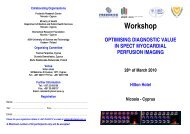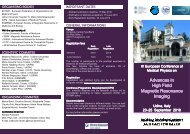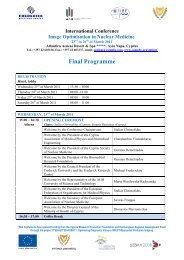medical physics international - Cyprus Association of Medical ...
medical physics international - Cyprus Association of Medical ...
medical physics international - Cyprus Association of Medical ...
- No tags were found...
You also want an ePaper? Increase the reach of your titles
YUMPU automatically turns print PDFs into web optimized ePapers that Google loves.
MEDICAL PHYSICS INTERNATIONAL Journal, vol.1, No.1, 2013availability <strong>of</strong> a library with the necessary resources, eitherin print or online. To satisfy the simultaneous study <strong>of</strong> atleast half <strong>of</strong> the student group (at a time). This model alsorequires good student testing during the delivery <strong>of</strong>education.At the other extreme (when minimal self-study isexpected) the overall contact hours could be <strong>of</strong> the order <strong>of</strong>800-900 hours. This model is useful for Regions orUniversities, where the libraries are not rich in resources,and most <strong>of</strong> the information is expected to be deliveredduring the lectures and labs. In this model the main resourcewhich students have for preparation for exams is theirlecture notes.When distributing the contact hours, one needs to build agood proportion for labs and other practical hours. Theirproportion could be estimated as ¼ <strong>of</strong> all contact hours.It should be emphasised, that contrary to some otherUniversity courses, attendance to <strong>Medical</strong> Physics lecturesshould be regarded as essential, and coursework delivery asobligatory. These requirements are very important for ourdynamic pr<strong>of</strong>ession, where books and other sources becomeout <strong>of</strong> date quickly.As a rough estimate, the sum <strong>of</strong> class contact and selfreadinghours <strong>of</strong> an MSc programme in <strong>Medical</strong> Physicswould be around 1100-1300 (including time for theexamination and feedback tutorials).MSC PROJECT AND THESISThe MSc project (or Diploma work) and related thesis is<strong>of</strong> great importance for the assessment <strong>of</strong> students’ ability toapply the acquired knowledge into practice. This researchelement <strong>of</strong> the education element should follow the abovedescribedtaught element. The nature <strong>of</strong> <strong>Medical</strong> Physicseducation allows for minimal overlap between these twoelements and the MSc projects should follow after thecompletion <strong>of</strong> the educational modules. It would beadvisable the subject <strong>of</strong> the MSc project to be linked to areal practical problem.The volume <strong>of</strong> the MSc thesis is <strong>of</strong>ten given as around15000 words, but this should not be a strict requirement, asdifferent theses would produce results which would includeelements which can not be measured this way (for exampleprogramming, drawings, etc.). However the thesis isexpected to be “publication-like” – i.e. including all majorelements <strong>of</strong> a typical research paper: Introduction;Literature search; Materials and Methods; Results;Discussion; Conclusion; Reference list.The difficulty <strong>of</strong> the project should be related to theapproximate time, which the student is expected to devoteto it. In many Universities this time is around 500-700hours.This MSc project time, added to the time for contact andself-reading above, would give an indicative overall length<strong>of</strong> the postgraduate (MSc-level) education programme <strong>of</strong>approximately 1700-1900 hours. Again, variations related tolocal requirements could significantly change this figure.Normally this length would be delivered either within onetwoacademic year (full time studies) or in two-threeacademic years (part time studies). Some local regulationscould require longer study time - e.g. 2 years for full timeMSc programme. Similarly the taught element <strong>of</strong> the fulltimeprogramme could be extended over 1 whole year, andthe MSc project could be developed over the second year(during which the student can have also some exposure tothe real practice <strong>of</strong> the pr<strong>of</strong>ession). Respectively suchdelivery <strong>of</strong> the programme could extend the Part-timedelivery and completion up to 4 years.STRUCTURE OF THE CURRICULUM AND MODELOF TEACHING DELIVERYThe MSc programme could be delivered either as acondensed full-time academic activity (most <strong>of</strong>ten over oneyear), or as a distributed part-time academic activity (most<strong>of</strong>ten over two years). Its organisation should be based on aprogressive structure, as many <strong>of</strong> the topics requirebackground from other previous topics. From this point <strong>of</strong>view a very suitable model for <strong>Medical</strong> Physics Educationis the modular model. One module is a finite element <strong>of</strong> thestudies, with separate assessment (for example RadiationProtection Module). Its length varies, but is <strong>of</strong>ten 30-40contact hours.In this model each subject from the educational structureis delivered in a condensed period <strong>of</strong> time (over 1-2 weeks).The model is very effective in regions, where theconcentration <strong>of</strong> lecturers is not sufficient. The modelallows for various lecturers to be called from otherUniversities (or cities and countries). The disadvantage <strong>of</strong>this model is related to the fact that when students misscertain element (due to illness, or other reason) they wouldhave great difficulty to be in pace with the group.A variation <strong>of</strong> the modular model is distributed delivery<strong>of</strong> lectures on different subjects, while keeping the logicallink between them. This model is more convenient for thestudents, but puts great pressure on the organisation, as amissing lecture (due to lecturer’s illness or other reason)could disrupt the logical line <strong>of</strong> knowledge delivery.Perhaps a suitable balance between these twopossibilities provides a good solution, which is used in anumber <strong>of</strong> Universities. This balance could be based onmainly distributed delivery <strong>of</strong> the basic topics (for whichone University could find local lecturers) and fully modular16






